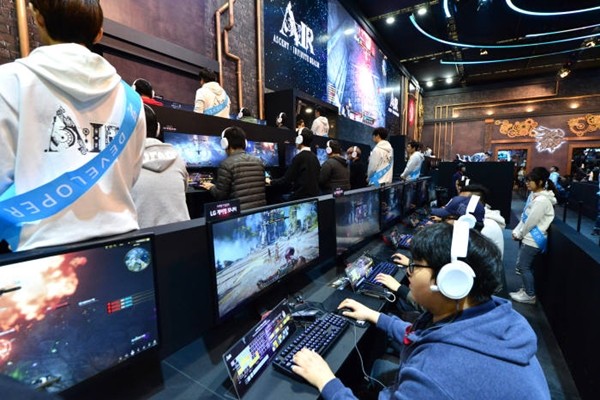G-STAR has regained its identity as a game show and its next task is to reestablish its position as one of global game shows.
G-STAR 2017 introduced many popular online and mobile games and truly enjoyed effects of being a ‘game show where one can directly see and feel’. It overcame a criticism towards lack of ‘realism’ in past two years when mobile games have become the mainstream.
It introduced special trial versions of major mobile games such as ‘Tera M’, ‘Icarus M’, ‘Overhit’, and ‘Blade & Soul Revolution’ and online games such as ‘FIFA Online 4’, ‘Air’, ‘Need 4 Speed Edge’, ‘Battlerite’, and ‘Titanfall Online’ that can only be experienced on scene for the first time.
Nexon and Netmarble Games set up hundreds of computers at their booths so that customers can enjoy trial versions. Some of the games such as Air became really popular as wait time alone was more than two hours.
G-STAR also played a role in having eSports competitions being actively held. First season of WEGL (World Esports Game & League) held by Actoz Soft was took place at G-STAR 2017 and it required the most number of booths at G-STAR 2017.
WEGL drew attention from spectators through popular games such as ‘StarCraft II’ and ‘Overwatch’ and indie games. Kakao Games and PUBG also introduced their eSports competition called ‘Battleground Invitational’ through G-STAR.
“I was able to enjoy G-STAR 2017 meticulously as G-STAR 2017 was evenly mixed with places where one can actually play games and eSports competitions where one can watch.” said Seo Ki-won who is a university student who visited G-STAR 2017.
Rate of participations by game industries was high as B2C Hall was closed early. “More businesses could have participated in this event if we were to secure more spaces beforehand.” said G-STAR.
G-STAR 2017 saw more than 40,000 visitors on the first day of G-STAR 2017 which is 6.9% more than the number of visitors who went to the first day of G-STAR 2016.

Games that were made by university students and startup companies also received positive comments as they were able to steal one’s attention through quality that is just as good as commercial games made by large companies.
“Fact that games made by university students or amateurs with possibilities of commercialization were seen here and there is one thing different from G-STAR 2016.” said a representative for a game developer. “Indication that points to South Korea’s game industries gaining more competitive edge can be felt from amateurs and small clubs.”
One thing that G-STAR needs to work on is to improve participation rate of global companies. Participation rate of global game companies such as Sony and Blizzard was low this year. It was difficult for them to enjoy effects of participating G-STAR as they either did not have any new games to introduce or already launched their major products.
Number of participants in B2B Hall for G-STAR 2017 increased by 0.9% compared to that of G-STAR 2017. Global businesses such as Tencent, Microsoft, Unity Technologies, Epic Games, and Alibaba Games participated mainly based on where their South Korean corporates are located.
Excluding investments from European and North American organizations, it is urgent to attract large global businesses. According to G-STAR, 1,365 buyers visited B2B Hall on the first day of G-STAR 2017. This number is 3% more than that of G-STAR 2016, and G-STAR needs to provide business opportunities that are useful for them.
“It is necessary for G-STAR to establish long-term strategies in order to attract major businesses.” said a representative for a game developer. “As more large game developers participate, rest of other companies can also enjoy trickle down effect.”
Staff Reporter Kim, Siso | siso@etnews.com